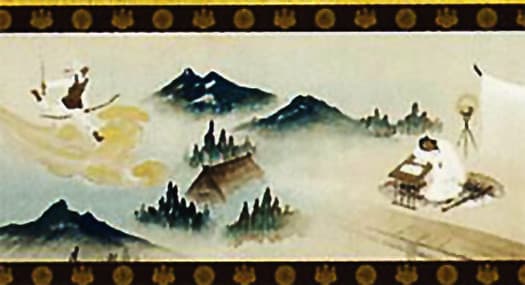



熊野地域という存在には北海道人であるわたしはほとんど知識がなかったのですが、実際に探訪してみてふとその「再生の地」という側面に触れて驚かされ続けておりました。実際に訪れたことで、その地域景観・民俗を知れば知るほどに奥行きが広がっていく思い。
しかし本来このブログシリーズはタイトル「皇統神話と熊野の旅」通り、いわば「通り道」探索という動機だったのです。たぶんふたたび熊野をめぐる旅に出るだろうと思っていますが、神話の霧に包まれた「神武東征」再起動の上陸地域としての熊野というスタートラインに一度、戻りたい。
資料としては熊野地域探訪後に訪れた橿原で触入手した、神武天皇を祀る橿原神宮が発行する「由緒略記」と、日本古代史と古典の第一人者とされる保田輿重郎氏による書籍「神武天皇」。神話と歴史の境界部分なのですが皇統神話の側に立った見方と承知した上で、参考にしたいと考えた次第です。
上の写真は、皇統が熊野地域に上陸地点の目印にした楯ヶ崎と、神武帝の兄2人が嵐に遭遇して海上で命を落として鎮魂された2つの神社の遠望位置と最有力とされる上陸地「二木島港」。
皇統の兄たち3人を失った神武帝一行は、この二木島に上陸して地元の勢力「丹敷戸畔〜にしきとべ」を討ち取って拠点を確保した。「丹敷」は二木島とも通じる地名。長躯の海上移動と大嵐遭遇で一行は疲労困憊していた。あたりで休んでいるとふいに大きな熊が現れ、その熊の毒気にみんなが気を失ってしまった。

そこに熊野地域の豪族・高倉下〜たかくらじ〜があらわれて「天神のお使いで高倉下が大刀を持って馳せ参じました」と大刀を献上したところ神武帝は「ああ、どうしたことだろう、ずいぶん長く寝ていたことだわい」と目覚めて、この大刀を受け取ったという。
大刀を受け取っただけなのに、熊野の山にいた悪い神たちはばたばたと倒れていった。そして東征軍全体は目覚め、立ち上がったのだという。神武帝は高倉下にこの神剣の由来を問うた。
「昨夜不思議な夢を見ました。夢の中でアマテラス大神が国譲りで功のあったタケミカヅチ(武御雷神〜鹿島神宮の祭神)を呼んで、そなたは一度平定したことがあるのだから天上から下って天孫を助けるようにと言った。それに対してタケミカヅチは自分がわざわざ行かなくともその時の大刀があるから地上に降ろしましょう、と言って高倉下の倉の屋根を貫いて落とした。そして、明日の朝目覚めたら、これを天孫の御子に奉れと言われ、目覚めたら本当に大刀があったので、そこで献上に参ったのです。」
この奇譚は神武帝の上陸に際しての消息を伝える伝説。高倉下という人物は尾張連の遠祖とされて朝廷に仕えることになる。祭神として祀る神社も熱田神宮境外摂社の高座結御子神社や、三重県伊賀市の高倉神社が知られている。熊野と伊勢国は海上交通で近接する地域であり、尾張もそのように考えられる。古代の海上交通勢力だったのではというのは自然な解釈だろう。
この奇譚には最初期の朝臣がどのようなものであったのか、が示唆されているのかも知れない。神話はこのあと大和進出の道先案内として「八咫烏」伝承に触れていく流れだが、こういう説話は神武東遷の協力者たちを直接に象徴化させていったのだろうか。
English version⬇
The Landing of Emperor Jinmu on Nigijima and the Divine Sword: Imperial Mythology and Kumano Journey-30
There is a probability that a landmark, Tategasaki, and shrines dedicated to his brothers who lost their lives in a sea accident exist at opposite angles to the point of the landing of Jinmu. What is the authenticity of the myths and legends after the landing? ...
As a Hokkaido native, I had little knowledge of the Kumano area, but I was continually surprised when I actually visited the area and came into contact with its aspect as a "place of rebirth. The more I learned about the local landscape and folk customs, the more I was surprised by the depth of the area.
However, that was originally my motive to explore "the path" so to speak, as the title of this blog series, "A Journey to Kumano and the Myth of the Imperial Lineage," suggests. I will probably go on a trip to Kumano again, but I would like to return to the starting point of Kumano as the landing area of the "Jinmu Tohei" (the eastern expedition to the east), which was shrouded in the mists of mythology.
As reference materials, I obtained by touch in Kashihara, which I visited after exploring the Kumano area, the "Brief History of the History" published by Kashihara Shrine, which enshrines Emperor Jinmu, and the book "Emperor Jinmu" by Koshijuro Yasuda, who is considered a leading expert on Japanese ancient history and classics. I would like to refer to these books, knowing that they are the boundary between myth and history, but taking the side of the myth of the imperial lineage.
The photo above shows Tategasaki, which was a landmark of the landing site of the Imperial lineage in the Kumano area, and the distant position of the two shrines where two of Emperor Jinmu's elder brothers lost their lives at sea in a storm and were reposed, as well as the most likely landing site "Futakishima Port".
After the loss of three of his imperial elder brothers, the Jinmu emperor and his party landed on this Nigijima and secured a base by defeating the local force "Tanshiki Toge - Nishikitobe. Tanshiki" is the name of a place also known as Niki Island. The group was exhausted from the long journey by sea and the encounter with the storm. While resting in the area, a large bear suddenly appeared, and the bear's venom caused everyone to faint.
The Emperor Jinmu woke up and said, "Oh, what is the matter, I have been asleep for a long time.
The bad gods in the mountains of Kumano fell down in a flurry, even though he had only received the great sword. The entire eastern expeditionary force then awoke and rose up. Emperor Jinmu asked Takakurakashita about the origin of this divine sword.
I had a strange dream last night. In the dream, Amaterasu called Takemikazuchi (Takemikazuchi - the god of thunder - the deity of Kashima Shrine), who had done so much to conquer the land, and told him to come down from the heavens and help his grandchildren, since you had once conquered the land. Takemikazuchi, on the other hand, said that he did not have to go all the way, but that he had the great sword from that time and that he would bring it down to earth, and dropped it through the roof of the storehouse under the Takakura. Then he told me to dedicate it to the Son of Heaven when I awoke tomorrow morning, and when I awoke, I indeed found the great sword, so I went there to dedicate it."
This strange tale is a legend that tells of the disappearance of Emperor Jinmu on the occasion of his landing. A man named Takagurashita was regarded as a distant ancestor of the Owari-ren and served the Imperial Court. Known shrines dedicated to him include Takazakayuko Shrine, a regency shrine outside the precincts of Atsuta Jingu Shrine, and Takakura Shrine in Iga City, Mie Prefecture. Kumano and Ise Province are in close proximity to each other in terms of maritime traffic, and Owari is also considered to be such a region. It would be a natural interpretation to suggest that they may have been an ancient maritime transportation power.
This tale may suggest the nature of the earliest imperial subjects. The myth then goes on to mention the legend of "Yatagarasu" as a guide to the advance to Yamato, and one wonders if this kind of tale directly symbolized the collaborators in the eastward migration of Jinmu.



















